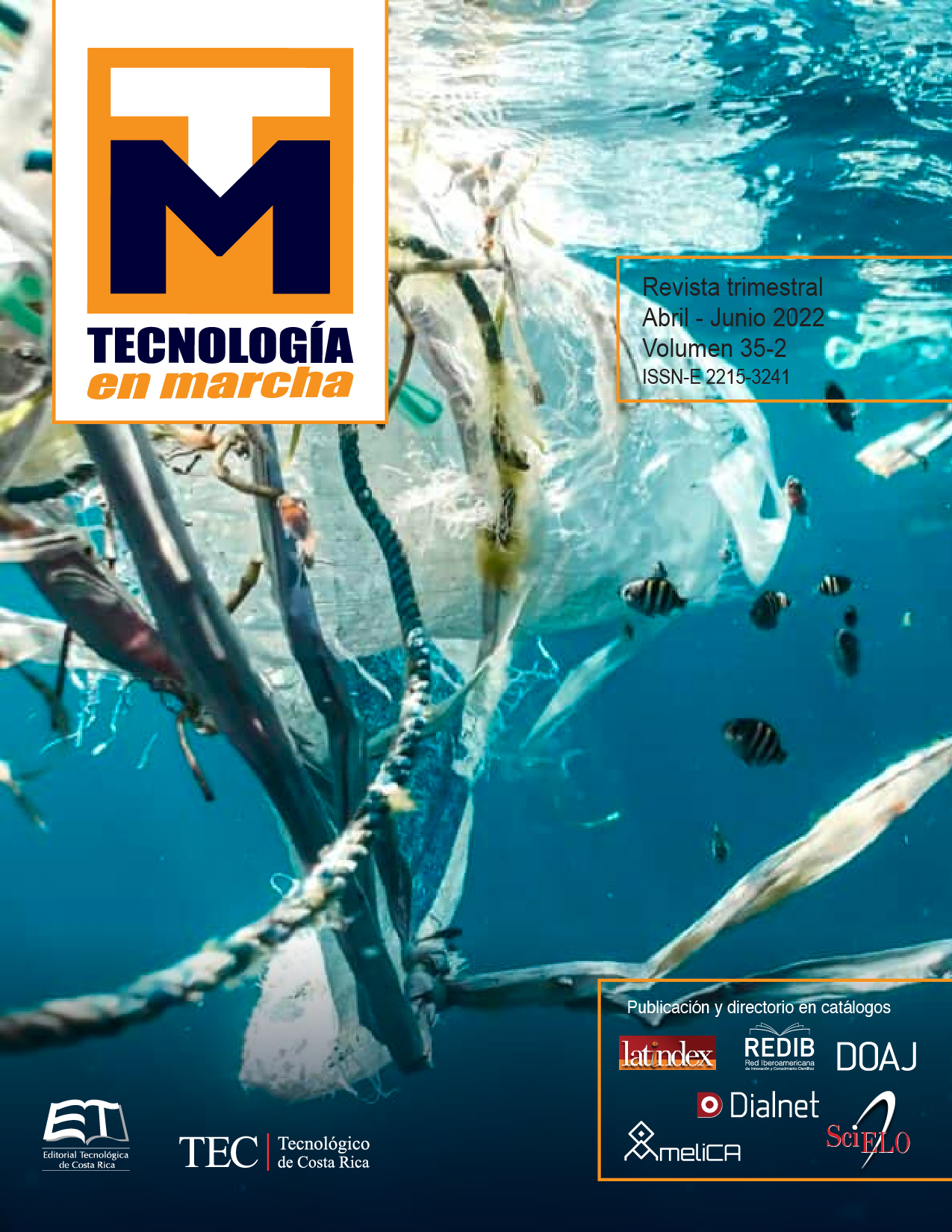Secado de Pinus caribaea var. hondurensis utilizando radiación de microondas
Contenido principal del artículo
Resumen
Se desarrolló una metodología de secado para Pinus caribaea var. hondurensis, empleando horno de microondas doméstico (HMO), consistente de pulsos de radiación y períodos de enfriamiento, que consume 92% menos energía y 58% menos tiempo. Las propiedades físicas y mecánicas se midieron en condición seca al HMO, equilibrio higroscópico (EH) y secado convencional, ρverde: 1049 ± 74 kg/m3 (CH: 107 ± 18 %), ρsecaHMO: 555 ± 63 kg/m3, ρEH: 565 ± 51 kg/m3 (CH: 11,3 ± 0,8 %), Vverde: 58 ± 1 x10-6 m3 y VHMO: 51 ± 26 x 10-6 m3 y contracción volumétrica: 11 ± 3 %, no presentando diferencias significativas con respecto al secado convencional. Los valores de la compresión paralela al grano fueron: ELPHMO: 6 ± 2 x 106 kg/m2, MRHMO: 6 ± 2 x 106 kg/m2 y MOEHMO: 4 ± 1 x 108 kg/m2, ELPEH: 3,0 ± 0,5 kg/m2, MREH: 3,5 ± 0,64 kg/m2 y MOEEH: 2,3 ± 0,6 kg/m2; tampoco mostraron diferencias con respecto al secado convencional. La única alteración anatómica observada fue un aumento de agrietamientos espiralados en las paredes de las traqueidas y no parece tener repercusión sobre las propiedades evaluadas. Se concluyó que la exposición al microondas no altera las propiedades estudiadas siendo un método confiable de secado.
Detalles del artículo

Esta obra está bajo una licencia internacional Creative Commons Atribución-NoComercial-SinDerivadas 4.0.
Los autores conservan los derechos de autor y ceden a la revista el derecho de la primera publicación y pueda editarlo, reproducirlo, distribuirlo, exhibirlo y comunicarlo en el país y en el extranjero mediante medios impresos y electrónicos. Asimismo, asumen el compromiso sobre cualquier litigio o reclamación relacionada con derechos de propiedad intelectual, exonerando de responsabilidad a la Editorial Tecnológica de Costa Rica. Además, se establece que los autores pueden realizar otros acuerdos contractuales independientes y adicionales para la distribución no exclusiva de la versión del artículo publicado en esta revista (p. ej., incluirlo en un repositorio institucional o publicarlo en un libro) siempre que indiquen claramente que el trabajo se publicó por primera vez en esta revista.
Citas
P. Benítez-Díaz y I. Gutiérrez-Gotera. Determinación de contenido de humedad en astillas de Pinus Caribaea Var. Hondurensis, utilizando un horno doméstico de microondas. Ingeniería, 20(1):17-24, 2010. DOI: 10.15517/RING.V22I1.8396
ONU. Desarrollo Sostenible, Antecedentes. Asamblea General de las Naciones Unidas, Presidente del 65° Período de Sesiones, 2010. http://www.un.org/es/ga/president/65/issues/sustdev.shtml (1 de abril de 2020).
J. Fernández-Golfín y J. López. La bomba de calor en el secado de la madera aserrada. Boletín de información técnica [de] AITIM, 213:69-74, 2001. Recuperado de: http://infomadera.net/uploads/articulos/archivo_4165_12322.pdf
M. Payette, T. Work, P. Drouin y A. Koubaa. Efficacy of microwave irradiation for phytosanitation of wood packing materials. Industrial Crops and Products, 69:187-196, 2015. DOI: 10.1016/j.indcrop.2015.01.030
C. Salinas, R. Ananias y D. Vasco. Modelling of Radio-frequency Heating of Piles of Pinus radiata Wood. BioResoursces, 13(1):945-953, 2018. https://ojs.cnr.ncsu.edu/index.php/BioRes/article/view/BioRes_13_1_945_Salinas_Modelling_Radio_Frequency_Heating_Pinus/5779 (1 de abril de 2020).
V.G. Zuin y L.Z. Ramin. Green and Sustainable Separation of Natural Products from Agro-Industrial Waste: Challenges, Potentialities, and Perspectives on Emerging Approaches. Topics in Current Chemistry (Z), 376(3):1-54, 2018. DOI: 10.1007/s41061-017-0182-z
A. Koubaa, P. Perré, R.M. Hutcheon y J. Lessard. Complex dielectric properties of the sapwood of aspen, white birch, yellow birch, and sugar maple. Drying Technology, 26(5):568-578, 2008. DOI: 10.1080/07373930801944762
M. Dubey, J. Janowiak, R. Mack, P. Elder y K. Hoover. Comparative study of radio-frequency and microwave heating for phytosanitary treatment of wood. European Journal of Wood and Wood Products, 74(4):491-500, 2015. DOI: 10.1007/s00107-016-1025-2.
L. Bandici, S. Coman y T. Leuca. The use of microwave field energy in the drying process of wooden sticks. Proceeding of 14th Iternational Conference on Engineering of Modern Electric System (EMES). Oradea, Romania, European Union, 2017. DOI: 10.1109/EMES.2017.7980390
L. Hansson y A. Antti. The effect of microwave drying on Norway spruce Woods strength: a comparison with conventional drying. Journal of Materials Proessing Technology, 141(1):41-50, 2003. DOI: 10.1016/S0924-0136(02)01102-0
L. Hansson y A. Antti. The efect of drying method and temperature level on the hardness of wood. Journal of Materials Processing Technology, 171(3):467-470, 2006. DOI:10.1016/j.jmatprotec.2005.08.007
M. Leiker y M. Adamska. Energy efficeiency and drying rates during vacuum microwave drying of wood. European Journal of Wood and Wood Products, 62(3):203-208, 2004. DOI: 10.1007/s00107-004-0479-9
G. Du, S. Wang, y Z. Cai. Microwave drying of wood strands. Drying Technology, 23 ç(12):2421-2436, 2005. DOI: 10.1080/07373930500340494.
E. Reyes, M. Molina, S. Valero, Y. Molina y J. Betancourt. Propiedades físicas de la madera de Pinus caribaea var. Hondurensis, resinado y no resinado de las plantaciones de Uverito (Monagas, Venezuela). Revista Forestal Venezolana, 56(1): 21-28,2012.
IAWA Committee. IAWA list of microscopic features for softwood identification. IAWA Journal, 25(1):1-702004. DOI: 10.1163/22941932-90000349
DEUSTCHE INDUSTRIE NORMEN (Normas DIN). Prüfung von Holz; Taschenbuch 31, 1988. Normen über Holz. Beuth-Verlag. 240 p.
ASTM. Designation: D 4442 – 92 (Reapproved 2003). Standard test methods for direct moisture content measurement of wood and wood-base materials. ASTM international, 2003. Recuperado de: http://file.yizimg.com/424653/2013121013320823.pdf (01/07/17)
S. Avramidis. Dielectric properties of four softwood species at low-level radio frequencies for optimized heating and drying. Drying Technology, 34(7):753-760, 2016. DOI: 10.1080/07373937.2015.1072719
Ö. Gezici-Koc, S. Erich, H. Huinink, L. van der Ven y O. Adan. Bound and free water distribution in wood during water uptake and drying as measured by 1D magnetic resonance imaging. Cellulose, 24(2):535-553, 2016. DOI: 10.1007/s10570-016-1173-x.
G. Du, S. Wang y Y. Zhang. Microwave Drying of Wood Strands. Drying Technology, 23(12):2421-2436, 2005. DOI: 10.1080/07373930500340494
E. Reyes, S. Valero, Y. Molina y J. Betancourt. Propiedades mecánicas de la madera de Pinus caribaea var. Hondurensis resinados y no resinados de las plantaciones de Uverito, estado Monagas, Venezuela. Revista Forestal Venezolana, 59(1):63-75, 2015.
A. Oloyede y P. Groombridge. The influence of microwave heating on the mechanical properties of Wood. Journal of Materials Processing Technology, 100(1-3):67-73, 2000. DOI: 10.1016/S0924-0136(99)00454-9

